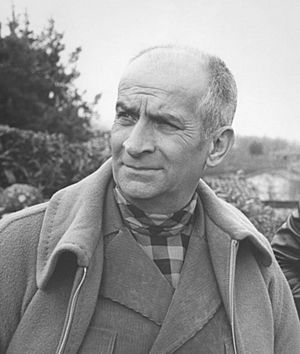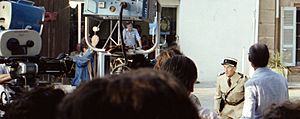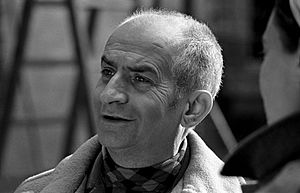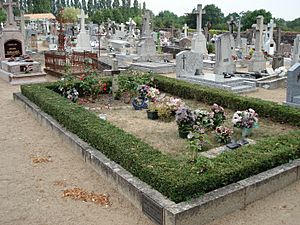Louis de Funès facts for kids
Quick facts for kids
Louis de Funès
|
|
|---|---|

Louis de Funès during the filming of the 1970 comedy film L'homme orchestre by Serge Korber
|
|
| Born |
Louis Germain David de Funès de Galarza
31 July 1914 Courbevoie, France
|
| Died | 27 January 1983 (aged 68) Nantes, France
|
| Other names | Fufu |
| Occupation | Actor |
| Years active | 1945–1982 |
| Spouse(s) | Germaine Louise Elodie Carroyer (m. 1936; div. 1942) Jeanne Barthelémy de Maupassant (m. 1943; 1983) |
| Children | 3, including Olivier |
| Awards | Grand prix du rire, 1957, Comme un cheveu sur la soupe Victoire du cinéma, 1965 César d'honneur, 1980 |
| Signature | |
 |
|
Louis de Funès (born Louis Germain David de Funès de Galarza; 31 July 1914 – 27 January 1983) was a famous French actor and comedian. Many people consider him one of France's most loved actors. He acted in over 150 films and more than 100 plays. People remember his acting style for being super energetic, with lots of funny faces and quick movements. Many of his best-known films were directed by Jean Girault.
Louis de Funès was one of the most famous French actors ever. He was very well-known in French-speaking countries. He was also a household name in many other parts of the world. This included German-speaking countries, the former Soviet Union, Eastern Europe, Italy, Spain, Greece, and Turkey.
Even with his international fame, Louis de Funès was not as well known in English-speaking countries. He was only introduced to a wider audience in the United States once. This was in 1974 with the movie The Mad Adventures of Rabbi Jacob. This film is famous for its Rabbi Jacob dance scene. It was even nominated for a Golden Globe Award. There are two museums dedicated to Louis de Funès. One is in the Château de Clermont near Nantes, where he lived. The other is in the town of Saint-Raphaël, Var in Southern France.
Contents
Early Life and Career Beginnings
Louis de Funès was born on July 31, 1914, in Courbevoie, France. His parents came from Seville, Spain. They moved to France in 1904 because their families did not approve of their marriage. His father, Carlos Luis de Funès de Galarza, was from a noble family. He was a lawyer in Spain but became a diamond cutter in France. His mother, Leonor Soto Reguera, was from Galicia, Spain.
Friends and family called Louis de Funès "Fufu." He spoke French, Spanish, and English. When he was young, he loved drawing and playing the piano. He went to the lycée Condorcet school in Paris. Later, he left school and had many small jobs. He often got fired from these jobs. He became a bar pianist, playing jazz in Pigalle, Paris. He made customers laugh with his funny faces.
He studied acting for one year at the Simon acting school. There, he met useful contacts, like Daniel Gélin. In 1936, he married Germaine Louise Elodie Carroyer. They had one son named Daniel. They divorced in 1942. In the early 1940s, de Funès kept playing piano in clubs. He thought there was not much demand for a short, bald, skinny actor. His wife and Daniel Gélin encouraged him to overcome his fear of rejection. His wife helped him a lot with his career.
During World War II, he continued his piano studies. He met and fell in love with a secretary named Jeanne Barthelémy de Maupassant. They married in 1943 and stayed together for 40 years. They had two sons: Patrick (born 1944), who became a doctor, and Olivier (born 1949). Olivier became a pilot and also acted in some of his father's films. These included Les Grandes Vacances and Fantômas se déchaîne.
Theatrical Career
De Funès started his acting career in the theatre. He had some success there and also played small roles in films. Even after he became a big movie star, he kept acting in plays. His theatre career reached its peak with a great performance in the play Oscar. He later played this same role in the film version.
Film Career Highlights
In 1945, Louis de Funès made his film debut at age 31. This was in Jean Stelli's La Tentation de Barbizon. He had a very small role as a doorman. He was on screen for less than 40 seconds. He went on to act in many films over the next 20 years. He played small roles in over 80 movies before getting his first main roles. During this time, he had a busy daily routine. In the mornings, he would lend his voice to other actors. In the afternoons, he filmed movies. In the evenings, he performed in plays.
From 1945 to 1955, he appeared in 50 films, often as an extra. In 1954, he starred in films like Ah! Les belles bacchantes. A big moment came in 1956 when he played Jambier in the World War II comedy, La Traversée de Paris. He became a star in 1963 with Jean Girault's film, Pouic-Pouic. This success meant de Funès would be the main star in all his future films. At 49, he became a major international star with the success of Le gendarme de Saint-Tropez. This film led to a series of six movies where he played a funny police officer.
He also worked with director Gérard Oury. They created a memorable team with Bourvil, another great comedian. They starred together in Le Corniaud (1965) and La Grande Vadrouille. La Grande Vadrouille was one of the most successful films ever made in France. It attracted 17.27 million viewers. It remains his biggest success. Oury wanted them to work together again in La Folie des grandeurs. But Bourvil passed away in 1970. So, de Funès starred with Yves Montand in that film instead.
Louis de Funès became France's top comic actor. Between 1964 and 1979, his films were the highest-grossing movies in France seven times. In 1968, all three of his films were among the top ten in France. This included Le Petit Baigneur.
He acted alongside many major French actors. These included Jean Marais and Mylène Demongeot in the Fantomas trilogy. He also worked with Jean Gabin, Fernandel, Coluche, Annie Girardot, and Yves Montand. He worked with Jean Girault in the famous 'Gendarmes' series. In a different kind of role, de Funès worked with Claude Zidi. Zidi wrote a new character for him in L'aile ou la cuisse (1976). This is often considered one of his best roles. De Funès also showed his musical talents in films like Le Corniaud. In 1964, he starred in the first of the Fantômas series. This film made him a huge superstar.
In 1975, Oury planned another film with de Funès called Le Crocodile. De Funès was to play a South American dictator. But in March 1975, de Funès had heart problems and had to stop acting. This caused Le Crocodile to be cancelled. After he got better, he appeared with another comic genius, Coluche, in L'Aile ou la cuisse. In 1980, de Funès fulfilled a long-time dream. He made a film version of Molière's play, L'Avare.
De Funès made his final film, Le Gendarme et les gendarmettes, in 1982.
Acting Style
In real life, de Funès was said to be a very shy person. This was different from the characters he played. He could make many different and quickly changing facial expressions. Because of this, he was called "the man with forty faces per minute." In many of his films, he played a funny, easily excited, grumpy, middle-aged man. His characters often had a lot of energy, were a bit sneaky, and had uncontrolled fits of anger. His short height (1.64 meters) and his funny facial movements made his acting very comical. This was especially clear when he acted with Bourvil. Bourvil always played calm, kind, and slightly naive characters. In de Funès' successful film version of Molière's The Miser (L'Avare), these traits were more subtle.
Later Years and Passing
In his later years, de Funès became very successful and wealthy. He was made a knight of France's Légion d'honneur in 1973. He lived in the Château de Clermont. This was a 17th-century castle near Nantes in western France. The castle overlooked the Loire river. His wife inherited it from her aunt. De Funès loved roses and planted a rose garden at the castle. A type of rose was even named after him: the Louis de Funès rose. A monument honoring him was placed in the rose garden.
In his later years, de Funès had heart problems. He had two heart attacks because of the stress from his acting. He passed away from a third heart attack on January 27, 1983. This was a few months after he made his last film. He was buried in the Cimetière du Cellier, the cemetery on the Château de Clermont grounds.
Legacy
De Funès was honored on a postage stamp issued by the French postal service in 1998. He also appeared in French comic books. For example, he was a gambler in Lucky Luke and a film studio worker in Clifton. In 2013, a museum dedicated to De Funès opened at the Château de Clermont where he had lived. In 2019, another De Funès museum opened in Saint-Raphaël, Var.
Filmography
| Year | Title | Role | Director | Notes |
|---|---|---|---|---|
| 1945 | La Tentation de Barbizon | Le portier du paradis | Jean Stelli | Uncredited |
| 1947 | Six heures à perdre | the driver | Alex Joffé and Jean Lévitte | |
| Le Château de la dernière chance | Bar Patron Hugging Yolande | Jean-Paul Paulin | Uncredited | |
| Dernier refuge | the driver | Alex Joffé | ||
| Antoine et Antoinette | Un garçon épicier / Un invité à la noce | Jacques Becker | Uncredited | |
| 1948 | Croisière pour l'inconnu | Le cuisinier | Pierre Montazel | Uncredited |
| 1949 | Du Guesclin | L'astrologue / Aymérigot Marches / un seigneur / un mendiant | Bernard de Latour | |
| Mission à Tanger | Le colonel espagnol | André Hunebelle | ||
| Je n'aime que toi | the orchestra's pianist | Pierre Montazel | ||
| Vient de paraître | Jacques Houssin | Uncredited | ||
| Millionnaires d'un jour | Philippe's solicitor | André Hunebelle | ||
| 1950 | Au revoir M. Grock | a spectator | Pierre Billon | Uncredited |
| Pas de week-end pour notre amour | Constantin, domestique du baron | Pierre Montazel | ||
| Mon ami Sainfoin | the guide | Paul-Adrien Schaye | ||
| Un certain monsieur | Thomas Boudeboeuf | Yves Ciampi | ||
| Rendez-vous avec la chance | the waiter | Emil-Edwin Reinert | ||
| Adémaï au poteau-frontière | Soldier | Paul Colline | Uncredited | |
| Father's Dilemma | Un prete | Alessandro Blasetti | ||
| His Last Twelve Hours | Nicolas | Luigi Zampa | Uncredited | |
| Quay of Grenelle | Monsieur Vincent – le quincailler | Emil E. Reinert | Uncredited | |
| The King of the Bla Bla Bla | Gino | Maurice Labro | ||
| Fugitive from Montreal | Jean Devaivre | |||
| Street Without a King | Hippolyte | Marcel Gibaud | ||
| Les joueurs | Piotr Petrovitch Spotniev | Claude Barma | TV movie | |
| 1951 | Bibi Fricotin | Le pêcheur | Marcel Blistène | |
| Folie douce | Jean-Paul Paulin | |||
| The Straw Lover | Bruno | Gilles Grangier | ||
| Without Leaving an Address | a father-to-be in the hospital | Jean-Paul Le Chanois | ||
| The Red Rose | Manito | Marcello Pagliero | ||
| Dr. Knock | Le malade qui a perdu 100 grammes | Guy Lefranc | Uncredited | |
| Boniface somnambule | Anatole | Maurice Labro | ||
| The Passerby | the lockmaster | Henri Calef | ||
| La vie est un jeu | Un voleur | Raymond Leboursier | ||
| They Were Five | Albert | Jack Pinoteau | ||
| Le Voyage en Amérique | un employee of Air France | Henri Lavorel | ||
| No Vacation for Mr. Mayor | the adviser | Maurice Labro | ||
| Le Dindon | the manager | Claude Barma | ||
| La poison | André Chevillard | Sacha Guitry | ||
| My Wife Is Formidable | a skier | André Hunebelle | ||
| Un amour de parapluie | Jean Laviron | Short, Uncredited | ||
| Jeanne avec nous | Claude Vermorel | Claude Vermorel | TV movie | |
| Champions Juniors | Pierre Blondy | Short, Uncredited | ||
| Boîte à vendre | Claude André Lalande | Short, Uncredited | ||
| 1952 | Wolves Hunt at Night | Waiter | Bernard Borderie | Uncredited |
| The Seven Deadly Sins | Martin Gaston, le Français | Yves Allégret | (segment "Paresse, La / Sloth") | |
| Monsieur Leguignon, Signalman | Un habitant du quartier | Maurice Labro | ||
| Agence matrimoniale | Charles | Jean-Paul Le Chanois | ||
| Love Is Not a Sin | Monsieur Cottin | Claude Cariven | ||
| Le jugement de Dieu | an employee | Raymond Bernard | Uncredited | |
| Je l'ai été trois fois | the sultan's interpreter | Sacha Guitry | ||
| Monsieur Taxi | Le peintre qui voit rouge | André Hunebelle | ||
| La Putain respectueuse | the night club visitor | Charles Brabant | ||
| She and Me | the waiter | Guy Lefranc | ||
| La Fugue de Monsieur Perle | Le fou qui pêche dans un lavabo | Pierre Gaspard-Huit | ||
| Le Huitième Art et la Manière | Le mari fan de radio | Maurice Regamey | Short | |
| La jungle en folie | Claude André Lalande | |||
| 1953 | Le rire | Himself | Maurice Regamey | |
| Tambour battant | Le maître d'armes | Georges Combret | ||
| La Vie d'un honnête homme | Émile | Sacha Guitry | ||
| Les Dents longues | an employee | Daniel Gélin | ||
| Au diable la vertu | Monsieur Lorette | Jean Laviron | ||
| The Tour of the Grand Dukes | Le directeur de l'hôtel | André Pellenc | ||
| The Sparrows of Paris | Doctor | Maurice Cloche | ||
| Les Compagnes de la nuit | Client | Ralph Habib | Uncredited | |
| Innocents in Paris | Célestin | Gordon Parry | ||
| Capitaine Pantoufle | Monsieur Rachoux | Guy Lefranc | ||
| Dortoir des grandes | Monsieur Triboudot | Henri Decoin | ||
| Légère et court vêtue | Paul Duvernois | Jean Laviron | ||
| Mon frangin du Sénégal | Doctor | Guy Lacourt | ||
| Le Chevalier de la nuit | Adrien Péréduray | Robert Darène | ||
| 1954 | Huis clos | Jacqueline Audry | ||
| L'Étrange Désir de monsieur Bard | Monsieur Chanteau | Géza von Radványi | ||
| Le Blé en herbe | Le forain | Claude Autant-Lara | ||
| Les Intrigantes | Monsieur Marcange | Henri Decoin | ||
| Mam'zelle Nitouche | Un maréchal des logis | Yves Allégret | ||
| Tourments | Eddy Gorlier | Jacques Daniel-Norman | ||
| Le Secret d'Hélène Marimon | Le jardinier Ravan | Henri Calef | ||
| Faites-moi confiance | Tumlatum | Gilles Grangier | ||
| The Pirates of the Bois de Boulogne | Le commissaire | Norbert Carbonnaux | ||
| Les hommes ne pensent qu'à ça | Monsieur Célosso | Yves Robert | ||
| The Sheep Has Five Legs | Pilate | Henri Verneuil | ||
| Poisson d'avril | Le garde-champêtre | Gilles Grangier | ||
| Service Entrance | Cesare Grimaldi | Carlo Rim | ||
| Scènes de ménage | Monsieur Boulingrin | André Berthomieu | ||
| Ah! Les belles bacchantes | Michel Lebœuf | Jean Loubignac | ||
| Les Impures | Le chef de train | Pierre Chevalier | Uncredited | |
| Queen Margot | René Bianchi | Jean Dréville | Uncredited | |
| Papa, maman, la bonne et moi | Monsieur Calomel | Jean-Paul Le Chanois | ||
| 1955 | Ingrid – Die Geschichte eines Fotomodells | D'Arrigio | Géza von Radványi | |
| The Babes Make the Law | Jeannot la Bonne Affaire | Raoul André | ||
| Napoléon | Soldier Laurent Passementier | Sacha Guitry | Uncredited | |
| Frou-Frou | Colonel Cousinet-Duval | Augusto Genina | ||
| L'impossible Monsieur Pipelet | Uncle Robert | André Hunebelle | ||
| Les Hussards | Luigi | Alex Joffé | ||
| Mädchen ohne Grenzen | Géza von Radványi | |||
| Papa, maman, ma femme et moi | Monsieur Calomel | Jean-Paul Le Chanois | ||
| 1956 | Si Paris nous était conté | Antoine Allègre | Sacha Guitry | |
| Bonjour sourire | Monsieur Bonoeil | Claude Sautet | ||
| La Bande à papa | L'inspecteur Victor Eugène Merlerin | Guy Lefranc | ||
| La Loi des rues | Paulo – les Chiens | Ralph Habib | ||
| Bébés à gogo | Monsieur Célestin Ratier | Paul Mesnier | ||
| Short Head | Prosper / Père Grazziani / Colonel Luc de la Frapinière / Le premier garçon de Turbolaria | Norbert Carbonnaux | ||
| La Traversée de Paris | Jambier | Claude Autant-Lara | ||
| 1957 | Comme un cheveu sur la soupe | Pierre Cousin | Maurice Regamey | |
| 1958 | Ni vu, ni connu | Léon Blaireau | Yves Robert | |
| Life Together | Maître Stéphane, le notaire | Clément Duhour | ||
| Taxi, Roulotte et Corrida | Maurice Berger | André Hunebelle | ||
| 1959 | Totò à Madrid | Prof. Francisco Montiel | Stefano Vanzina | |
| I Tartassati | Hector "Ettore" Curto | Stefano Vanzina | ||
| Mon pote le gitan | Monsieur Védrines | François Gir | ||
| 1960 | Certains l'aiment froide | Ange Galopin | Jean Bastia | |
| Candide ou l'optimisme au XXe siècle | Gestapo officer | Norbert Carbonnaux | ||
| Les Tortillards | Emile Durand | Jean Bastia | ||
| 1961 | Captain Fracasse | Scapin | Pierre Gaspard-Huit | |
| La Belle Américaine | Viralot | Robert Dhéry | ||
| Dans l'eau qui fait des bulles | Paul Ernzer | Maurice Delbez | ||
| 1962 | Les Sept péchés capitaux | (several) | ||
| La Vendetta | Valentino Amoretti | Jean Chérasse | ||
| Le Crime ne paie pas | Le barman du 'Blue Bar' | Gérard Oury | (segment "L'homme de l'avenue") | |
| Le Diable et les Dix Commandements | Antoine Vaillant | Julien Duvivier | (segment "Bien d'autrui ne prendras") | |
| The Gentleman from Epsom | Gaspard Ripeux | Gilles Grangier | ||
| Un clair de lune à Maubeuge | Jean Chérasse | Uncredited | ||
| Nous Irons A Deauville | Ludovic Lambersac | Francis Rigaud | ||
| 1963 | Les Veinards | Antoine Beaurepaire | Philippe de Broca and Jean Girault | (segment "Un gros lot") |
| Carambolages | Norbert Charolais | Marcel Bluwal | ||
| Pouic-Pouic | Léonard Monestier | Jean Girault | ||
| 1964 | Faites Sauter la Banque | Victor Garnier | Jean Girault | |
| Des pissenlits par la racine | Jack | Georges Lautner | ||
| Une souris chez les hommes | Marcel Ravelais | Jacques Poitrenaud |
| Year | Title | Role | Director | Co-starring | Notes |
|---|---|---|---|---|---|
| 1964 | Le gendarme de Saint-Tropez | Maréchal des logis-chef Ludovic Cruchot | Jean Girault | ||
| Fantômas | Commissioner Juve | André Hunebelle | Jean Marais, Mylène Demongeot | ||
| 1965 | Le Corniaud | Léopold Saroyan | Gérard Oury | Bourvil | |
| Les Bons Vivants | Léon Haudepin | Gilles Grangier and Georges Lautner | Mireille Darc | (segment "Bons vivants, Les") | |
| Le gendarme à New York | Maréchal des logis-chef Ludovic Cruchot | Jean Girault | |||
| Fantômas se déchaîne | Commissioner Juve | André Hunebelle | Jean Marais, Mylène Demongeot | ||
| 1966 | Le Grand Restaurant | Monsieur Septime | Jacques Besnard | ||
| La Grande Vadrouille | Stanislas Lefort | Gérard Oury | Bourvil, Terry-Thomas | ||
| 1967 | Fantômas contre Scotland Yard | Commissioner Juve | André Hunebelle | Jean Marais, Mylène Demongeot | |
| Oscar | Bertrand Barnier | Édouard Molinaro | |||
| Les grandes vacances | Charles Bosquier | Jean Girault | |||
| 1968 | Le Petit Baigneur | Louis-Philippe Fourchaume | Robert Dhéry | ||
| Le tatoué | Félicien Mézeray | Denys de La Patellière | Jean Gabin | ||
| Le gendarme se marie | Maréchal des Logis-chef Ludovic Cruchot | Jean Girault | |||
| 1969 | Hibernatus | Hubert Barrère de Tartas | Édouard Molinaro | ||
| 1970 | L'homme orchestre | Monsieur Edouard | Serge Korber | ||
| Le gendarme en balade | Maréchal des logis-chef Ludovic Cruchot | Jean Girault | |||
| 1971 | Sur un arbre perché | Henri Roubier | Serge Korber | Geraldine Chaplin | |
| Jo | Antoine Brisebard | Jean Girault | |||
| La folie des grandeurs | Don Salluste de Bazan | Gérard Oury | Yves Montand | ||
| 1973 | Les aventures de Rabbi Jacob | Victor Pivert | |||
| 1976 | L'aile ou la cuisse | Charles Duchemin | Claude Zidi | Coluche | |
| 1978 | La Zizanie | Guillaume Daubray-Lacaze | Annie Girardot | ||
| 1979 | Le gendarme et les extra-terrestres | Ludovic Cruchot | Jean Girault | ||
| 1980 | L'avare | Harpagon | Louis de Funès and Jean Girault | ||
| 1981 | La Soupe aux choux | Claude Ratinier | Jean Girault | ||
| 1982 | Le gendarme et les gendarmettes | Maréchal des Logis-chef Ludovic Cruchot | Jean Girault et Tony Aboyantz | (final film role) |
See also
 In Spanish: Louis de Funès para niños
In Spanish: Louis de Funès para niños
- Rabbi Jacob dance




